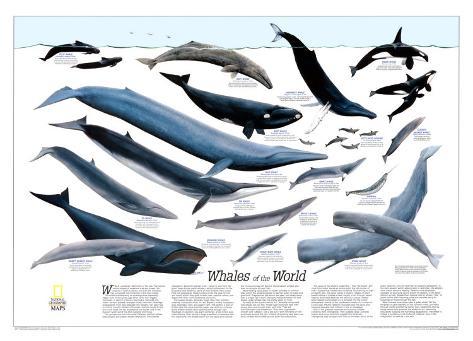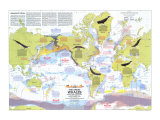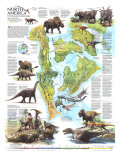WHALE. Leviathan. Mammoth of the sea. The names excite images of awesome size and power. No creature in Earth's history, not even the dinosaur, has surpassed the immensity of the blue whale.
The whale's ascendancy to sovereign size apparently began six million years ago when hairy, four-legged mammals, in search of food or sanctuary, ventured into water. As eons passed, changes slowly ocurred: Hind legs disappeared, front legs changed into flippers, hair gave way to a thick, smooth blanket of blubber, nostrils moved to the top of the head, the tail broadened into fluckes, and in the buoyant water world the body became enormous.
Two groups now form the order Cetacea: toothed whales (Odontoceti) and baleen whales (Mysticeti). The toothed cetaceans–about 65 species in all–range in size from the giant, deep-diving sperm whales–as big as boxcars–to the porpoises and dolphins, some of them smaller than a man. Fast and agressive, these hunters prowl the seas for fish and squid, which they grab in their jaws, swallow whole, and digest with their multichambered stomachs.
The baleen whales, generally larger than their toothed relatives, include the blue, fin, sei, Bryde's, minke, humpback, gray, bowhead, right, and pygmy right. The baleen, a wall of bristly slats that grow from the upper jaw, acts as a strainer. Some baleen whales swim openmouthed through was meadows of plankton, like giant combines, while others gulp intermittenly. After taking a large quantities of seawater and tiny organisms, the whales squirt out the liquid and swallow the minute anmals left behind. some baleen whales also feed on schools of small fish.
Most feeding takes place in higher latitudes in summer, after which the whales migrate to warmer water to breed and give birth. Pregnancies last about one year, and rarely more than a single calf is born. Sexually mature between six and eleven, great whales may live eighty years or more.
As early as the fourth century B.C., Aristotle recognized that whales are not fish. These huge mammals bear their young alive and nourish them with milk. They are warm-blooded and breathe air. Their skin is generally smooth and rubbery–like a wet suit–with remnants of hair, principally around the lips. Instead of swishing tails back and forth, whales drive flukes up and down for locomotion.
The spout is the whale's trademark. “Thar she blows” still rings from ship' decks as sailors sight the tall plumes of mist–signals that whales have surfaced. Fountaining as high as twenty feet, the spout marks a whale's release of spent breath before it inhales a fresh supply of air through valved nostrils. Scientists describe the blow as a cloud created when steamy compressed air is exhaled into the colder atmosphere, similar to the condensed breath of a human on a chilly day. Recent research indicates that the spout also contains seawater that collects in the air passages.
One of the greatest mysteries surrounding whales concerns their intelligence. They possess large, complex brains, and some scientists suggest that cetacean intelligence may compare with that of primates. Much of the brain, however, may be reserved for acoustic perception. In the dark aquatic world, where vision is restricted, the whale's most useful sense is hearing. Dolphins and porpoises navigate by bouncing sound waves off objects, in the same fashion as bats. Reserches believe that all whales “talk” to some extent; their haunting cries and whistles carry for hundreds of miles through the sea.
Most humans have never seen a great whale. Yet the leviathan is cast indelibly on the common mind, put there through myths scripted by fearful men, adventures told by hardy sailors who pursued the whale for oil, reports by naturalist studying the marvelous adaptations. The whale is indeed a ponderous and profound creature, alive in the imagination as well as in the sea.
PILOT WHALE - Globicephala melanena, 18 feet - Often called the blackfish, the pilot whale has been known to come ashore in mass strandingins, a phenomenon that scientists are still striving to explain.
GRAY WHALE - Eschrichtius robustus, 45 feet - Barnacles and sking pibments give these baleen whales a mottled hue. They apparently need little food or rest on their long migratory journeys.
HUMPBACK WHALE - Megaptera novaeangliae, 45 feet - Emitting long, etheral “songs,” the humpback steers with huge, winglike flippers. It arches its back sharply to begin its dive, displaying a prominent dorsal fin.
KILLER WHALE - Orcinus orca, 25 feet - Hunting in packs, this largest dolphin attacks fish, seals, and an occasional great whale, In captivity it is gentle with humans.
CUVIER'S BEAKED WHALE - Ziphius cavirostris, 20 feet - Little is known about this rarely sighted species, which was first identified in 1823.
BOTTLENOSE DOLPHIN - Tursiops truncatus, 9 feet - This frisky species, familiar to many because of television and films, is the cetacean most adaptable to captivity.
NARWHAL - Monodon monoceros, 14 feet - The male features a long, spiral tusk, actually an enlarged tooth of uncertain use, which may have prompted legends of unicorns.
SPERM WHALE - Physeter catodon, 55 feet - Largest of the toothed whales, the sperm ines on squid and irsh and may dive a mile or more. It can remain submerged for at least an hour.
MINKE WHALE - Balaenoptera acutorostrata, 25 feet - Named in jest for a Norwegian whaler who once confused smaller whales with the enormous blues, the curious minke comtimes approaches ships, or is caught in cod nets.
BRYDE'S WHALE - Balaenoptera edeni, 45 feet - This warmwater cetacean, often mistake for the sei, feeds on shrimplike krill as well as on small schooling fish such as sardines and anchovies.
PYGMY RIGHT WHALE - Caperea marginata, 16 feet - sometimes mistaken for the minke, ths whle has a profile, coloration, and sie that sets it apart from the other species in the Balaenidae family: the right and bowhead.
FIN WHALE - Balaenoptera physalus, 75 feet - The spout of this baleen giant ascends as hight as 20 feet, following dives that last 10-15 minutes.
BOWHEAD WHALE - Balaena mysticetus, 50 feet - The chunky “Greenland right.” its head almost athird of its length, occasionally uses its powerful brow to break through Arctice for a breath.
SEI WHALE - Balaenoptera borealis, 50 feet - Deriving its name from a Norwegian word for pollack, a fish that appears in the same waters, the swift sei can sprint up to 20 knots when fleeing harpooners.
BAIRD'S BEAKED WHALE - Berardius bairdii, 35 feet - Second to the sperm in size among toothed whales, the “giant bottlenose” displays a bulging forehead. It dwells only in the North Pacific.
BLUE WHALE - Balaenoptera musculus, 90 feet - The blue has been known to reach nearly 100 feet in length. While suckling, it may grow 200 pounds a day, and, once mature, can daily devour as much as eight tons of krill–planktonic crustaceans.
RIGHT WHALE - Eubalaena glacialis, 50 feet - Hunters dubbed this callus-capped whale “right” because it was slow, floated when dead, and supplies large quantities of oil and baleen. Scientists are uncertain whether there are one, two, or three species.















